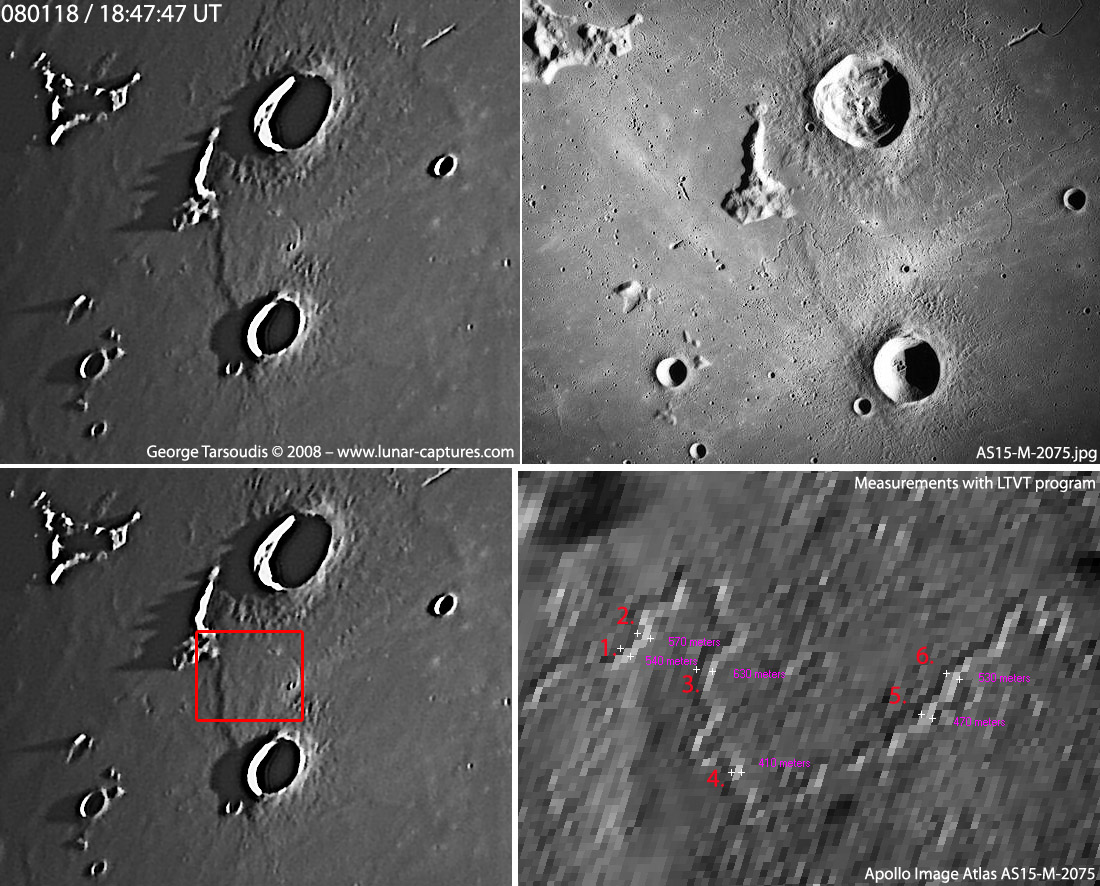Difference between revisions of "LPOD Feb 5, 2008"
| Line 1: | Line 1: | ||
<div id="content_view" class="wiki" style="display: block"> | <div id="content_view" class="wiki" style="display: block"> | ||
=CURIOUS= | =CURIOUS= | ||
| − | <br /> [[Image:LPOD-Feb5-08.jpg|LPOD-Feb5-08.jpg]]<br /> ''left images by [mailto:g.tarsoudis@freemail.gr George Tarsoudis,] Alexandroupoli, Evros, Greece; right images from NASA AS15-M-2075. Back away from your screen and squint your eyes to improve the view of the enlargement.''<br /> <br /> It is surprising how many gaps there are in our knowledge of the Moon. Even rudimentary knowledge such as how big something is. George noticed that in the Moon-Wiki page for the [[Rima%20Diophantus|Diophantus Rille]] there was no width given, it was simply said to be narrow. George was curious and asked: How narrow? So he used the [http://inet.uni2.dk/~d120588/henrik/jim_ltvt.html LTVT tool] to measure its width on his image, finding a value of 830 m. Then he measured it in six different locations on the splendid Apollo image and found values ranging from 410 m to 630 m, with an average of 525 m. Why the difference? Two reasons. First, its harder to measure accurately on a lower resolution image. Second, rilles are constant width, perhaps he measured a place where the rille was widest. In any case, this is a narrow rille, and its remarkable to [http://higginsandsons.com/astro/images/Delisle-Diophantus_06-07-06_S115.jpg image] even pieces of it with amateur telescopes. I just noticed that the Moon-Wiki page does not include a depth for the rille...<br /> <br /> ''Chuck Wood''<br /> <br /> '''Technical Details'''<br /> 18 Jan, 2008, 18:47:47 UT. 10" at f/6.3 + DMK 21AF40 with barlow projection + filter green, Registax, PS<br /> <br /> '''Related Links'''<br /> Rükl plate 19<br /> George's [http://www.lunar-captures.com/ website]<br /> [http://tech.groups.yahoo.com/group/lunar-observing/message/21249 More] on measuring the rille<br /> <br /> '''[[LPOD%20Index|Index]] of past LPOD's'''<br /> <br /> | + | <br /> [[Image:LPOD-Feb5-08.jpg|LPOD-Feb5-08.jpg]]<br /> ''left images by [mailto:g.tarsoudis@freemail.gr George Tarsoudis,] Alexandroupoli, Evros, Greece; right images from NASA AS15-M-2075. Back away from your screen and squint your eyes to improve the view of the enlargement.''<br /> <br /> It is surprising how many gaps there are in our knowledge of the Moon. Even rudimentary knowledge such as how big something is. George noticed that in the Moon-Wiki page for the [[Rima%20Diophantus|Diophantus Rille]] there was no width given, it was simply said to be narrow. George was curious and asked: How narrow? So he used the [http://inet.uni2.dk/~d120588/henrik/jim_ltvt.html LTVT tool] to measure its width on his image, finding a value of 830 m. Then he measured it in six different locations on the splendid Apollo image and found values ranging from 410 m to 630 m, with an average of 525 m. Why the difference? Two reasons. First, its harder to measure accurately on a lower resolution image. Second, rilles are constant width, perhaps he measured a place where the rille was widest. In any case, this is a narrow rille, and its remarkable to [http://higginsandsons.com/astro/images/Delisle-Diophantus_06-07-06_S115.jpg image] even pieces of it with amateur telescopes. I just noticed that the Moon-Wiki page does not include a depth for the rille...<br /> <br /> ''Chuck Wood''<br /> <br /> '''Technical Details'''<br /> 18 Jan, 2008, 18:47:47 UT. 10" at f/6.3 + DMK 21AF40 with barlow projection + filter green, Registax, PS<br /> <br /> '''Related Links'''<br /> Rükl plate 19<br /> George's [http://www.lunar-captures.com/ website]<br /> [http://tech.groups.yahoo.com/group/lunar-observing/message/21249 More] on measuring the rille<br /> <br /> '''[[LPOD%20Index|Index]] of past LPOD's'''<br /> <br /> <br /> <br /> </div> |
Latest revision as of 14:39, 15 April 2018
CURIOUS

left images by George Tarsoudis, Alexandroupoli, Evros, Greece; right images from NASA AS15-M-2075. Back away from your screen and squint your eyes to improve the view of the enlargement.
It is surprising how many gaps there are in our knowledge of the Moon. Even rudimentary knowledge such as how big something is. George noticed that in the Moon-Wiki page for the Diophantus Rille there was no width given, it was simply said to be narrow. George was curious and asked: How narrow? So he used the LTVT tool to measure its width on his image, finding a value of 830 m. Then he measured it in six different locations on the splendid Apollo image and found values ranging from 410 m to 630 m, with an average of 525 m. Why the difference? Two reasons. First, its harder to measure accurately on a lower resolution image. Second, rilles are constant width, perhaps he measured a place where the rille was widest. In any case, this is a narrow rille, and its remarkable to image even pieces of it with amateur telescopes. I just noticed that the Moon-Wiki page does not include a depth for the rille...
Chuck Wood
Technical Details
18 Jan, 2008, 18:47:47 UT. 10" at f/6.3 + DMK 21AF40 with barlow projection + filter green, Registax, PS
Related Links
Rükl plate 19
George's website
More on measuring the rille
Index of past LPOD's